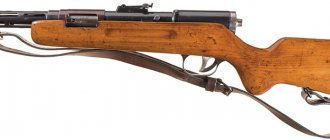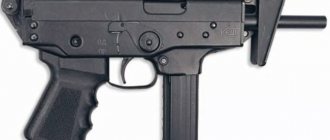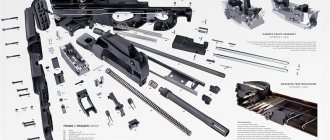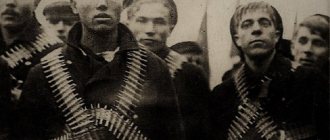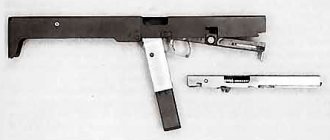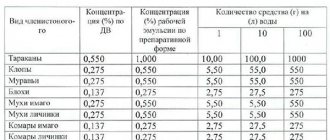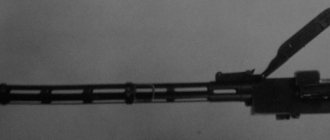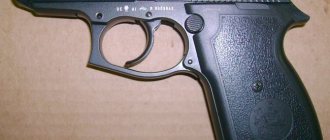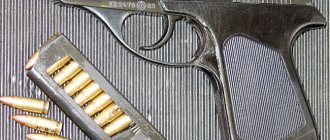History of creation[edit]
The MP5 submachine gun was first introduced by Heckler & Koch in 1966, under the name HK54
.
This name was chosen according to the old model numbering system that identified the weapon as a submachine gun, and the number “4” determined that the submachine gun was chambered for the 9x19mm Parabellum cartridge. It received its modern name after the German government adopted it into service with the police and border guards in mid-1966 as Maschinenpistole 5
, or MP5 for short. Thanks to the use of the submachine gun by the German counter-terrorist squad GSG9, which was part of the border guard service, similar special forces of other Western countries had the opportunity to become familiar with its characteristics.
To expand the range of possible applications of submachine guns, various branches were created: small-caliber personal defense weapons (English: Personal Defense Weapon (PDW)
), such as the HK MP7 and compact carbines such as the G36C, a shortened version of the HK G36 assault rifle, and the XM8, also based on the G36. Heckler & Koch has begun replacing the MP5 line with the cheaper HK UMP model, which is available in versions chambered for .45 ACP, .40 S&W and 9x19 mm Parabellum. However, since the UMP uses a simpler blowback automatic, it may not be a worthy competitor to the MP5 for demanding shooters.
Reflection in culture and art
In computer games
The submachine gun appears in the computer game in the World War I setting Battlefield 1
called “PP “Maxim” 08/18” (eng. SMG 08/18) and is available for the “Stormtrooper” class with the release of the add-on “In the Name of the Tsar”, dedicated to the Russian Empire. Since there is no technical data on the weapon's rate of fire, in the game the submachine gun is depicted with a rate of fire of 770 rounds per minute and it overheats after firing 30 rounds in a row[8].
Design description[edit]
The MP5 automatic operates on the semi-blowback principle, firing is carried out from a closed bolt. The hammer-type trigger mechanism allows firing in automatic and single mode. The fuse is also a fire mode translator. Its lever is located near the fire control handle on the left side. When the safety is engaged, the trigger and hammer are blocked, which ensures safety in handling the weapon. The shutter is locked in the forward position by rollers, which simultaneously act as a shutter accelerator. This design made it possible to reduce recoil and increase accuracy of fire. The sight is drum type, diopter or open (selected by turning the rear sight drum).
Site about weapons, weapons of all times and peoples, types of weapons
The Spanish company Bonifacio Echeverria Star SA, created in 1905 in Eibar, introduced a new automatic pistol for the country's armed forces and police, as well as for export sale. The pistol was called Star 28 DA. It went into mass production in February 1980 and was available in 28 PDA and 28 PKDA versions. Development of the project began in 1976 under the leadership of chief designer Eduard Iraegi. Although these pistols are not standard issue in any country, it can be assumed that they are used by the armed forces and police, at least outside of Spain.
Since its founding, the Spanish company has earned a reputation as a manufacturer of high-quality handguns. Star pistols are weapons widely known throughout the world, which are designed according to the Browning system and are constantly modified. The company produced several versions of these pistols, loaded with cartridges of different calibers.
The Star 28 DA pistol comes with a spring trigger. It works on the principle of double and single action. The 28 PDA is shorter and lighter than the standard version. The weapon is made entirely of steel, but the Model 28 PKDA has a frame made of light metal. All models are loaded with 9x19 ammunition from the same 15-round metal magazines.
The automatic operation of the Star 28 DA pistol is based on the use of recoil energy. The weapon has a locking bolt, a short-stroke barrel and an external trigger. The barrel is made of a high-strength alloy, which is not hardened after processing. The sight can be moved to the side using the screw located on the right. The front sight has a width of 3 mm and a low height. The sight line length is 160 mm, the barrel rifling pitch length is 355 mm.
There is a charging indicator on the top rear part of the slide. The pistol can also be operated by left-handers, since the safety lever is actuated on both sides. The magazine release is located on the left side at the height of the trigger, which is operated by the thumb of the right hand. When firing using the double action principle, the trigger resistance is 4.5 kg.
The main parts of the weapon are made from forged blanks, the triggers are made from profile material, the trigger tongues are made from cast parts, and the handle cheeks are made from plastic. The weapon is well crafted and very durable.
Characteristics: automatic pistol Star 28 DA Caliber, mm - 9 Initial bullet velocity (v0), m/s - 380 Weapon length, mm - 205 Weapon height, mm - 135 Sight line length, mm - 160 Loaded weight, kg - 1.325 Unloaded weight, kg — 1.140 Cartridge — 9×19 Barrel length, mm — 110 Rifling/direction — 6/p Magazine capacity, cartridges — 15 Effective range, m — 50
Characteristics: Star 28 PDA automatic pistol Caliber, mm - 9 Initial bullet velocity (v0), m/s - 380 Weapon length, mm - 193 Loaded weight, kg - 1,285 Unloaded weight, kg - 1,100 Cartridge - 9× 19 Barrel length, mm — 98 Rifling/direction — 6/p Magazine capacity, cartridges — 15 Effective range, m — 50
Characteristics: automatic pistol Star 28 PKDA Caliber, mm - 9 Initial bullet velocity (v0), m/s - 380 Weapon length, mm - 193 Weight when loaded, kg - 1.045 Weight when unloaded, kg - 0.860 Cartridge - 9× 19 Barrel length, mm — 98 Rifling/direction — 6/p Magazine capacity, cartridges — 15 Effective range, m — 50
Related posts:
- None Found
Advantages[edit]
- High muzzle energy, stopping and penetrating effect of the bullet.
- High accuracy of firing in single and short bursts from stable positions, largely due to the semi-free bolt.
- The handle has a good angle and shape, allowing you to securely hold the weapon. Placing the safety flag and fire mode close to it allows you to conveniently switch it without weakening your grip on the handle. *The ability to use various types of sights, a silencer and a tactical flashlight expands the capabilities of the weapon.
- Phosphated coating of parts makes the weapon resistant to adverse external conditions.
- The PP can be easily disassembled for cleaning and lubrication.
- High reliability.
Disadvantages[edit]
Green Beret with MP5K.
- Relatively high rate of fire, which leads to bullet dispersion when firing from unstable positions.
- Low impact resistance; If accidentally dropped, the drum sight may be damaged.
- Sensitivity to pollution.
- Less preferable for submachine guns is firing from the front sear (closed bolt), which leads to two-center hits during automatic fire.
- Relatively long reloading procedure.
Options and modifications[edit]
- MP5
is a basic model with a non-folding stock, adopted by the German police and border guards in 1966. - MP5A1
- 1966 model with a sliding telescopic stock. - MP5A2
- with a permanent hollow plastic buttstock, which has a sling swivel for attaching a belt. - MP5A3
- with retractable telescopic buttstock. An early model, with a grooved forend and a stamped steel trigger module housing. - MP5A4
is a development of the MP5A2 with a “cut-off” firing mode of 3 rounds. - MP5A5
is a development of the MP5A3 with a “cut-off” firing mode of 3 rounds. - MP5SD
is a silent version of the 1974 model with an integrated PBS and a perforated barrel. The sound of a shot is almost inaudible at a distance above 30 m. - MP5K
is a compact modification from 1976 with a shortened barrel and fore-end equipped with an additional handle for holding the weapon. - MP5SF
- self-loading version of 1986 for the British police. - MP5N
- modification for the US Navy, the barrel additionally has threads for attaching American standard silencers. - MP5F
- modification for the French armed forces. - MP5K-PDW
(
Personal Defense Weapon
) - 1991 model with a stock that was missing on the K modification. - MP5/10
- variant chambered for 10mm Auto, produced from 1992 to 2000. The FBI purchased 1,400 pieces. - MP5/40
- variant chambered for .40 S&W, produced from 1992 to 2000. - The HK94
is a commercial self-loading version for sale in the United States with a barrel extended to 16 inches, produced from 1983 to 1989. - SP89
(
Sport Pistole M1989
) is a commercial self-loading version of the MP5K, produced from 1989 to 1994. - MKM-091
is a semi-automatic carbine chambered for 9×21 mm, produced in Ukraine.
Literature
- de Vries G.;
Martens BJ Ⅰ. Vollmer and Erma Submachine Guns // The MP38, 40, 40/1 and 41 Submachine Gun. — 1st Edition. - Arnhem: Special Interest Publicaties BV (English) Russian, 2001. - Vol. 2. - P. 9. - 152 p. — (The Propaganda Photo Series). — ISBN 90-805583-2-X. — ISBN 978-90-805583-2-8. (English) - Howson G.
32. Conclusions / Appendix ɪɪ / A. Polish arms shipments to Spain, 9 September 1936 – 25 September 1937 // Arms for Spain: The Untold Story of the Spanish Civil War. - First US Edition. — New York: St. Martin's Press (English) Russian, 1999. - P. 263. - 354 p. — ISBN 0-312-24177-1. — ISBN 978-0-312-24177-3. (English) - Heinz, L.R.
Small Arms of the Spanish Civil War: [English] // Forgotten Weapons (English) Russian. : article. — 2020. — 26 August. — P. 11. — 45 p.
Operating countries[edit]
- Australia - some special forces.
- Austria - is in service with the EKO Cobra special forces unit.
- Azerbaijan - in 2006 - 2012 270 units were purchased in Turkey. MP.5 submachine guns made in Turkey. Used by special forces.
- Belarus - in service with the special forces of the SPBT "Almaz", the special forces of the KGB "Alpha", and the riot police in Minsk.
- Belgium - some special forces.
- Vatican - MP5A3 used by the Swiss Guard.
- Great Britain - for the police the first 12 pieces. were purchased in 1984, later they entered service with mobile “quick reaction” teams (a team of three police officers has 3 revolvers and two MP.5), airport security and special police units, various modifications are used by SAS.
- Germany - mass-produced to this day, adopted for service in the mid-1960s.
- Greece - MP5 is produced.
- Georgia - batch of MP5A1 received from Turkey.
- India - used by the army and special forces.
- Indonesia - is in service with special forces.
- Italy - Carabinieri of Italy.
- Kazakhstan - MP5 is used by various special forces, MP5K is used by Baikonur guards.
- Canada - Used by the Royal Canadian Navy and some other special forces.
- China - a copy of Norinco NR08
. - Republic of China
- Malaysia - used by the army and special forces.
- New Zealand - some special forces.
- Norway - the MP5 submachine gun was produced in Norway since 1984 under license at the Konsberg Vapenfabrikk plant and was used in the army and police until 2007, when it was replaced by the HK MP7 purchased from Germany.
- Pakistan - several modifications of the MP.5 are produced under license at the Wah-1 enterprise.
- Poland - in service with special forces GROM, FORMOZA, military gendarmerie, police and the Ministry of Finance.
- Portugal - is in service with special forces.
- South Korea - is in service with special forces.
- Russia - a certain number is in service with the Airborne Forces and Navy, as well as the special forces of the FSB "Alpha" and "Vympel".
- Serbia - in service with the anti-terrorist special forces PTJ of the Serbian Ministry of Internal Affairs.
- USA - used by a number of special forces.
- Thailand - Used by the police.
- Türkiye - produced by MKEK.
- Ukraine - presidential security, Main Intelligence Directorate of the Moscow Region, Central Security Service "A" of the SBU, National Guard of Ukraine.
- Philippines - is in service with the army, special forces and police.
- Japan - is in service with the Special Boarding Unit, Special Assault Team, Special Security Team, Japanese Special Forces Group (MP5SD6), and the Imperial Guard.
Notes
- ↑ 1 2 3 4 5 6 7 McCollum, Ian.
Experimental German 08/18 Maxim SMG.
Submachine Guns (English). Forgotten Weapons (English)Russian
(9 May 2014). Retrieved September 11, 2020. Archived September 11, 2020. - ↑ 1234
de Vries, Martens, 2001, p. 9. - ↑ 1 2 3 Popenker, Maxim.
It's been a while since we've had real, exclusive exotic weapons (Russian).
Livejournal
. LiveJournal (May 7, 2014). Retrieved September 12, 2020. Archived September 12, 2020. - Nathan S.
Mystery German WW1 Sub Machine Gun (English).
TheFirearmBlog.com
. AllOutdoor.com (August 4, 2015). Retrieved September 11, 2020. Archived September 11, 2020. - McCollum, Ian.
Weapons of the Spanish Civil War (English).
Forgotten Weapons (English)Russian
(4 October 2016). Retrieved July 8, 2020. Archived July 8, 2018. - Howson, 1999, p. 263.
- Heinz, 2020, p. eleven.
- "Indigownd" Dalunde, Joye.
Battlefield 1 "In the Name of the Tsar" Update - Update Notes (Russian).
Battlefield.com
. Electronic Arts (September 11, 2017). Retrieved September 11, 2017. Archived September 11, 2020.
